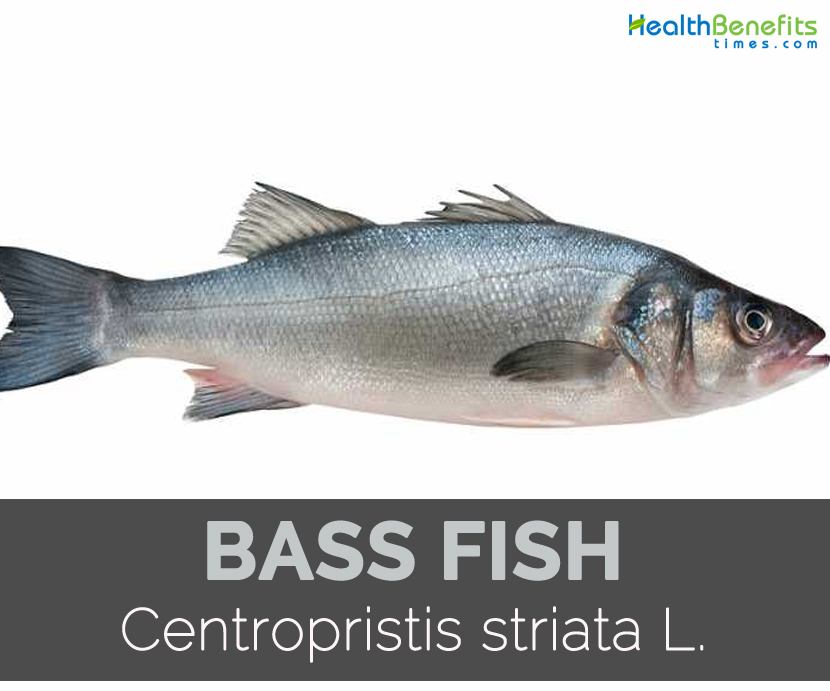| Bass fish facts and benefits Quick Facts |
| Name: |
Bass fish facts and benefits |
| Scientific Name: |
Centropristis striata L. |
| Origin |
The word bass is derived from the Middle English bars that mean perch. It is mostly found in Northern ranges. It resides coasts of Maine to Northeast Florida and Easter Gulf of Mexico. |
| Colors |
Blue to black, smoky gray and dusky brown |
| Shapes |
Oblong, compressed, stout and Length: 12 inches |
| Flesh colors |
White |
| Calories |
125 Kcal./cup |
| Major nutrients |
Selenium (85.64%)
Isoleucine (65.49%)
Lysine (65.31%)
Tryptophan (60.45%)
Threonine (59.20%)
|
| Health benefits |
Cancer prevention, Reduce weight, Healthy heart, Treats diabetes, Bone health |
| More facts about Bass fish facts and benefits |
Centropristis striata also called Black sea bass, humpback (larger males), black bass, rock bass, pinbass sea bass is a protogynous hermaphrodite fish of the Serranidae family found mostly in Northern ranges. It resides coasts of Maine to Northeast Florida and Easter Gulf of Mexico. The body is blue to black, smoky gray and dusky brown in color with white flesh. The tail is straight edged or rounded. Black sea bass is believed to live upto 20 years. This fish is oblong, compressed, stout and measures upto 12 inches long. This bass measures upto 1 pound. The eggs of Black sea bass are 0.95 mm (0.037 inches) Crabs, small fishes, shrimp, squid, barnacles and razor clams are its prey.
Nutritional value
One fillet of 129 grams of Sea bass grants 100.97 g of water, 125 calories, 23.77 g of protein, 2.58 g of total lipid fat and 1.41 g of ash. It contains 47.1 µg of selenium, 1.095 g of isoleucine, 2.184 g of lysine, 0.266 g of tryptophan, 1.042 g of threonine, 1.226 g of valine, 0.7 g of histidine, 1.932 g of leucine, 23.77 g of protein, 0.516 mg of pyridoxine, 250 mg of phosphorus, 0.968 mg of pantothenic acid, 0.39 µg of cobalamine, 78.4 mg of choline, 2.064 mg of niacin, 53 mg of magnesium, 0.155 mg of riboflavin and 0.142 mg of thiamin.
Health Benefits of Bass fish
Bass is low in calories and contains high amount of selenium, protein and omega-3 fatty acids. It helps to lower the chances of cardiovascular ailments, blood pressure and level of cholesterol. As it contains mercury, it should be consumed in lower amounts.
- Cancer prevention
It has high content of omega-3 fatty acids which is a good fat that is essential for maintaining HDL cholesterol in the body. It is also associated to lower the chances of cancer. (1)
- Reduce weight
It is loaded with sufficient minerals, nutrients and protein which is essential for losing weight. (2)
- Healthy heart
It helps to balance omega-6 and omega-3 fatty acids in the body. It maintains balance in cholesterol and prevents the chances of atherosclerosis, obesity as well as coronary heart disease. It also reduces the strain on heart and arteries. (3)
- Treats diabetes
Protein is considered to the vital part of diet. Fish are the natural source of protein. It helps to reduce the chances of diabetes. (4)
- Bone health
It is also an excellent source of selenium, magnesium, calcium, zinc and other minerals that prevents the bones. The high presence of minerals is essential for the maintenance of long term strength and health. (5)
- Eye ailments
It contains high amount of Vitamin A which is an antioxidants that is associated with vision and eye health. It helps to prevent the damage of free radicals that could lead to cataracts and macular degeneration by promoting the vision. (6)
- Assist growth
Protein helps to prevent the chances of chronic ailments which is essential for the development as well as growth. The protein obtained from sea food and poultry is healthy in comparison to red meat. It assists in the repair of muscles, tissue and bone. (7)
Precautions
- It should be consume in moderate amounts.
- The raw fish might cause parasitic infections.
How to Eat
http://thelocalcatch.com/black-sea-bass/
Other Facts
- The world record for the black sea bass weight is 4.65 kg (10 lb 4 oz).
- It turns dull black to white when it is taken out of water.
- They could live upto 15 or 20 years.
- They are predators which rely on its large mouth as well as swift movements to catch its prey.
- They feed on amphipods, shrimp and isopods.
- It is a protogynous hermaphrodite which firstly as females and then turn to males.
- All fish could not reverse sex.
References:
http://www.chesapeakebay.net/fieldguide/critter/black_sea_bass
http://dnr2.maryland.gov/fisheries/Pages/Fish-Facts.aspx?fishname=Black%20Sea%20Bass
Comments
comments


